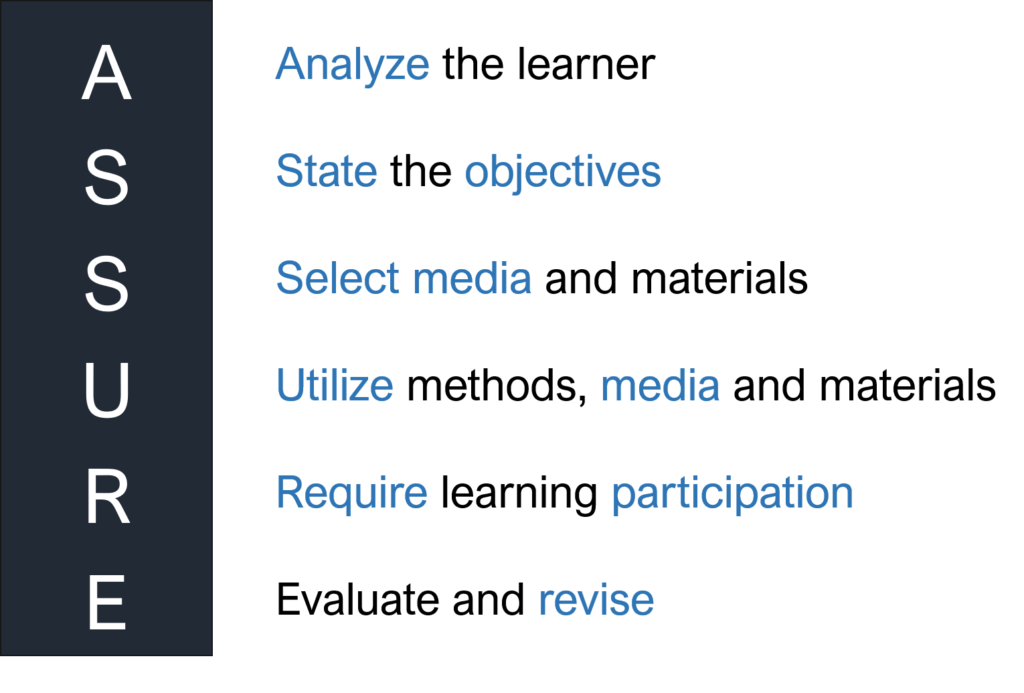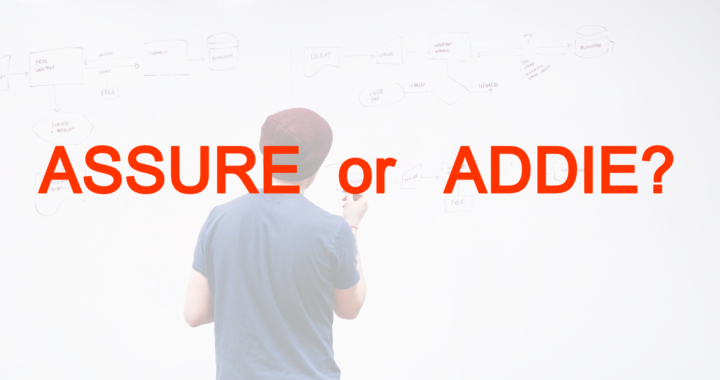ADDIE is the Analysis, Design, Development, Implementation and Evaluation framework of Instructional System Design (ISD). It’s the most popular concept in Learning and Development (L&D) for the workplace and academia. It has erroneously been called an ISD model and the dough for every L&D pastry in the world. If you are a learning professional, you most likely heard of it, if you are student, you definitely heard of it and if you ever had to work with Instructional Designers, they probably explained it to you as “the process” for developing effective instruction. ADDIE has proven highly effective for the US military, who’s probably to this date, it’s biggest customer. ADDIE’s fame has cast a shadow over actual ISD models to the point of obscuring them from consideration. One of those ISD models is the Analyze Learners, State the Objectives, Select media and materials, Utilize media and materials, Require learner participation, Evaluate and revise or ASSURE model. This model has been around since 1981 and evolving ever since, so why is it not a more common staple in L&D practice? Can ASSURE be a substitute of ADDIE? Let’s take a look into ASSURE and answer theses questions.
The ASSURE Model
Just like ADDIE, the ASSURE model is an academic model of instruction.
“The ASSURE model is an instructional system or guideline that teachers can use to develop lesson plans which integrate the use of technology and media.” (Heinich, Molenda, Russell & Smaldino, 1999). The model has been part of the book Instructional Technology and Media for Learning which is currently in its 12th edition. The key focus of the model is on the learner and the technology/media used. According to a review by none other than Professor Robert Maribe Branch for the University of Georgia, “Instructional designers should find the systematic approach used in the content of this book as an excellent example of how to practice instructional design in a K-12 setting”(Branch, 2014). Although Dr. Branch’s review offers an academic perspective, he also mentions that “Even self-directed students will be able to apply the book’s content as an independent learner as they study various aspects of technology related to teaching” (Branch, 2014). With this in mind, let’s consider the various stages in the ASSURE model.
Analyze Learners
The first step in ASSURE is to analyze the learners. This is clear guidance that this model is learner-centered. Analyzing learners includes knowing “demographics like education level, age and specific entry competencies which translate to prior knowledge, skills, and attitudes about the topic.”(Smaldino, et al, 2008). This looks like a great start and similar to the creation of personas in other approaches, such as Design Thinking and Learning Experience Design (LXD).
State Objectives
This stage is not much different than the common Design stage in ADDIE and the best practice in writing learning objectives. However, in ASSURE, the learning objectives are focused on four pillars labeled Audience, Behavior, Conditions and Degree or ABCD for short. Here’s how it works:
Audience
Start with a statement that addresses the Audience. For example; At the end of this (lesson, course, activity), you will be able to do (insert expected behavior).
Behavior
The objective must address a learner Behavior that’s observable, so it can be evaluated. The use of action verbs a lá Bloom’s Taxonomy is highly recommended and the avoidance of non-observable like ‘appreciate’, ‘grasp’ or ‘understand’.
Conditions
Environmental conditions are not common in L&D objectives, but ASSURE requires them. Conditions in the objectives refer to the tools and technologies available to learners. This may be a good addition in workplace settings to consider environmental impact on learning performance i.e. digital vs physical space, LMS platforms, etc.
Degree
Degree as stated in ASSURE, is perhaps the most relevant element of a learning objective. It refers to the expected degree of performance. This is something that I repeatedly see missing in workplace learning objectives. For example, if we want a customer service representative to effectively perform an electronic refund; then, this part of the objective would address how well the task will be performed and in what span of time.
Select Media and Materials
After stating objectives, ASSURE dictates that the selection of media and technology is key to connect the beginning stages from entry competencies to desired behavioral change as stated in the objectives. Strategies recommended here may involve content curation or any of the recommended application of technologies for best results as recommended by the book. For example; if learners are dispersed globally, they are computer literate or use smart devices, then elearning technologies can be a good fit.
Utilize Methods, Media, & Materials
After selecting the media, ASSURE focuses in how the media will be implemented and the systemic impacts of using such media. In our previous example, we had eLearning technologies as a possible conduit. In this stage you are focusing on which are the best technologies and how learners will use the selected media.
Require Learning Participation
This is my favorite stage of ASSURE as it requires active and experiential learning components in learning solutions. A key component mentioned in the model is the need for learner feedback prior to conducting assessments. Learners must do activities that support their learning and they often need to be personalized.
Evaluate and Revise
The final piece of the ASSURE model is evaluation and revision of the instructional process. This can be tremendously helpful in workplace learning, but I must admit, difficult to achieve. The idea is to not only evaluate learner performance, but evaluate the learning solution. Determine what worked and removed what didn’t essentially.

ASSURE vs ADDIE
Alright, now that we got the basics, let’s get to a short comparison between ASSURE and ADDIE. The main weakness in ASSURE is that it’s not intended to be an ISD process model, but is a more accurate approach than ADDIE for instruction in learning environments where technology media is involved. Why? Because it’s a prescriptive model delineating the expected actions at each of its stages. Conversely, ADDIE is so vague that two instructional designers working on the same team can disagree on what happens at any stage of the process. However, ADDIE serves as a general compass to navigate the waters of determining whether a performance problem needs to be solved with a learning solution or not. This is something ASSURE does not seem to address. ASSURE does provide better guidance on writing objectives and being learner-centered. ADDIE however, has become more than a notion. To many, ADDIE is a belief and many learning professionals swear passionately by it. I even wrote a TD Magazine article on how to Integrate ADDIE with digital learning development which was well received.
Wrap Up
As an instructional designer and Learning Experience Designer (LXD), I’m curious as to why ASSURE is not as popular as ADDIE. This probably stems from ASSURE’s strong focus on academic setting and also, there’s no more marketable acronym than ADDIE to cover the whole gamut of ISD methodologies. ADDIE is easy to explain, but executing it to its fullest is quite a different experience. Finally, the workplace is quickly evolving and ISD does not seem to be able to keep up, forcing many instructional designers to evolve out of ADDIE. Maybe a modified version of ASSURE could be the answer.
References
Branch, R. (2014). The ASSURE Model: The Legacy Continues. Educational Technology, 54(6), 60-61. Retrieved from http://www.jstor.org/stable/44430327
Smaldino, S. E. dkk. 2008. Instructioal technology and media for learning.

